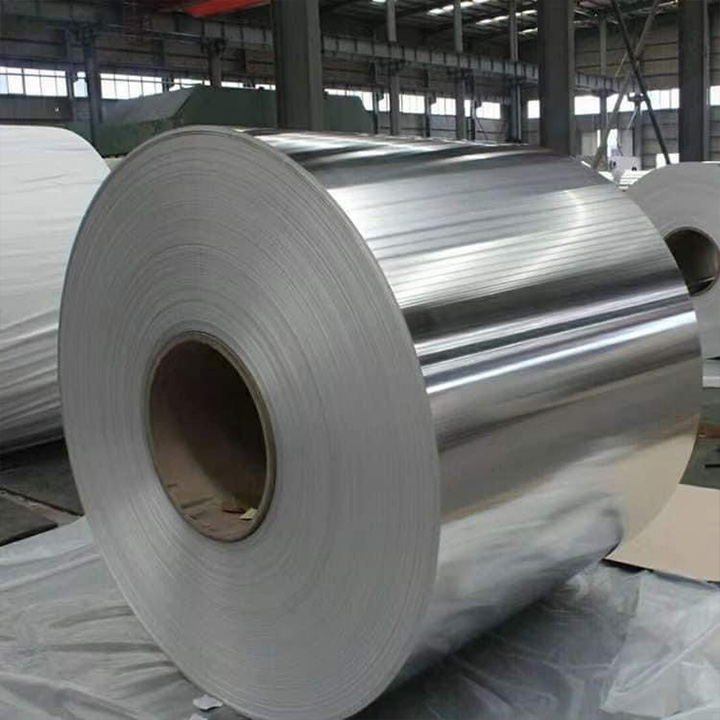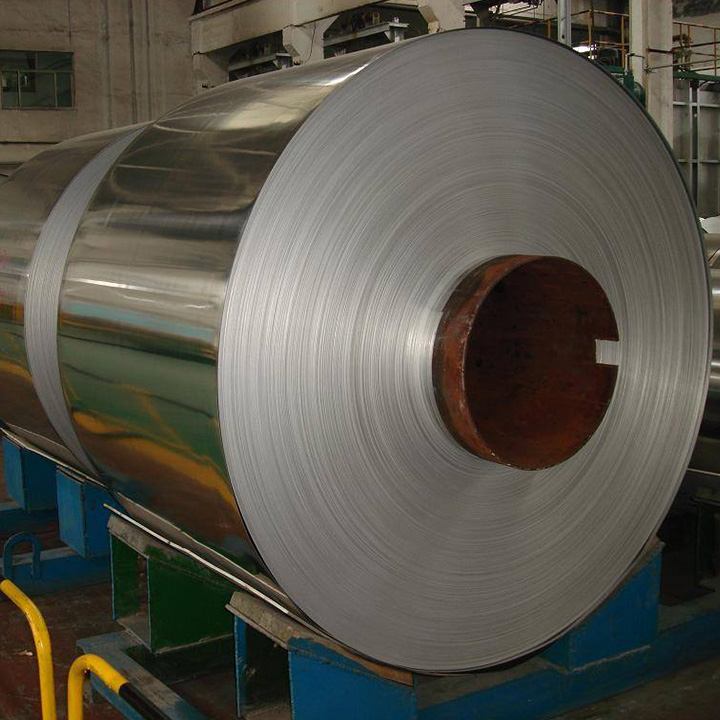- +86 188 5310 8009
- info@northchinametal.com
- Shuntai North Road, High-tech Zone, Jinan City, Shandong Province
Call Us
Mail To
Address
Shuntai North Road, High-tech Zone, Jinan City, Shandong Province
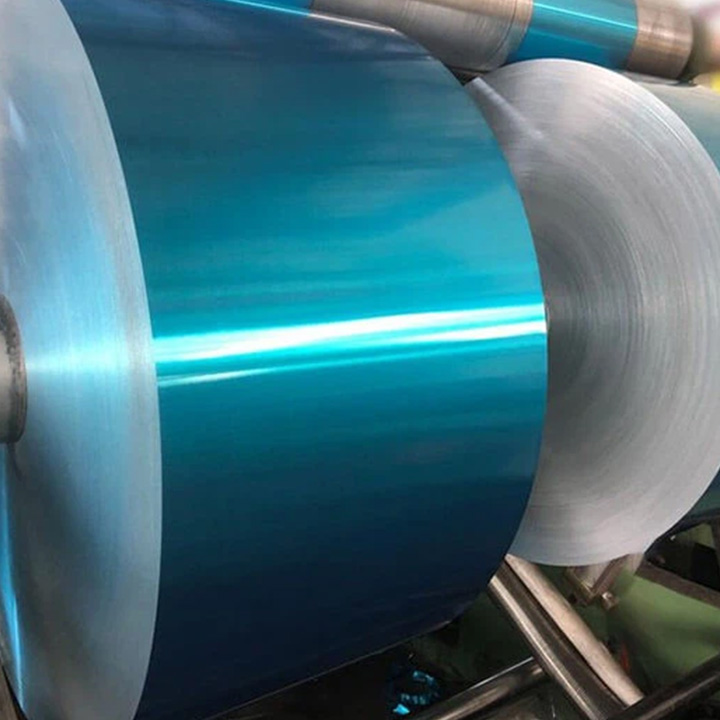
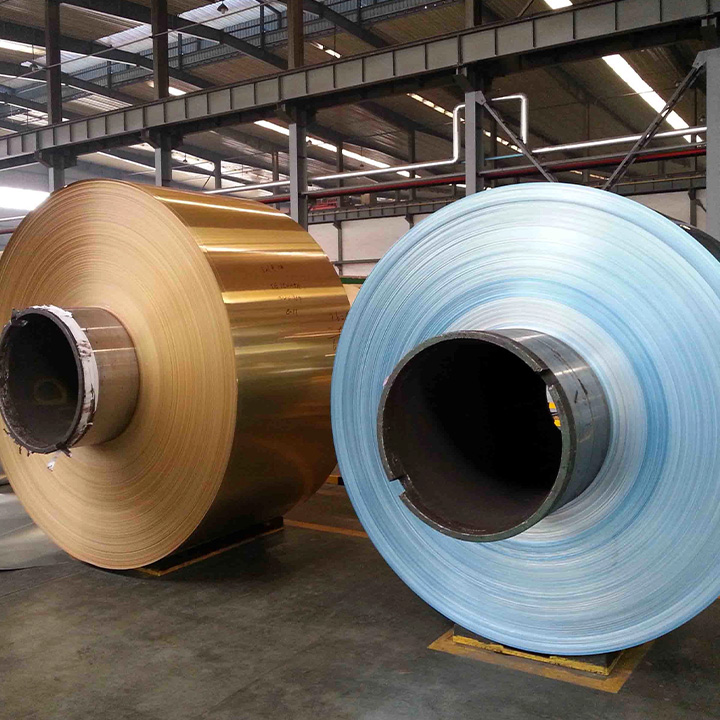
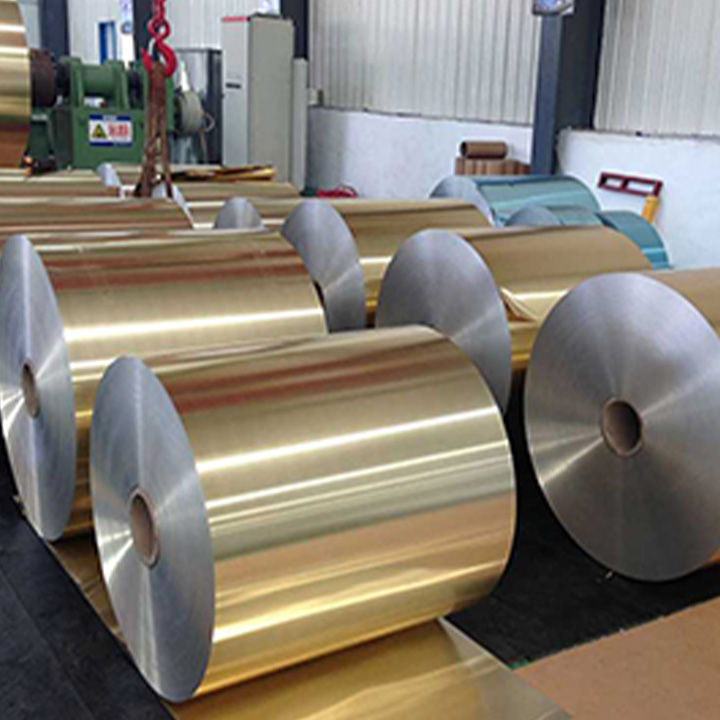



Hydrophilic aluminum foil
Hydrophilic aluminum foil is a kind of aluminum foil that has been treated with hydrophilicity. Through a special process, a hydrophilic layer is coated on its surface. The condensed water will quickly disperse on the hydrophilic aluminum foil and will not condense into water droplets, thereby increasing the heat exchange area, speeding up the cooling and heating speed, and effectively avoiding the noise caused by condensed water blocking the air flow.
Hot selling aluminum alloy series of hydrophilic lacquered aluminum foil
- 8011 H16 hydrophilic lacquered aluminum foil
For the refrigerant pipes in the air conditioning system and the casing of the outdoor air conditioning unit.
- 1100/1200 O H11 hydrophilic lacquered aluminum foil
Good processability and corrosion resistance, suitable for applications such as air conditioning, heat exchangers, and evaporators.
- 1030B H22 hydrophilic lacquered aluminum foil
Manufacturing of fins for air conditioning systems and industrial radiators. Improve water droplet diffusion and optimize heat exchange performance.
- 3102 H24 hydrophilic lacquered aluminum foil
Used for heating fins for air conditioning systems possess good hydrophilicity and heat dissipation effects.
- 8006 H26 hydrophilic lacquered aluminum foil
It has good hydrophilicity and is suitable for improving the heat exchange efficiency of air conditioning systems.
- 3003 hydrophilic lacquered aluminum foil
Used for hydrophilic fins in air conditioning systems to optimize heat exchange performance.
| Mechanical Properties of Common Aluminum Foil for Hydrophilic Foil | ||||
| Alloy-Temper | Thickness Range (mm) | Tensile Strength (MPa) | Elongation (%) | Cupping Test Value (mm) |
| 1030B H26, 3102 H26 | 0.085-0.09 | 130-140 | ≥13 | ≥5.2 |
| 1030B H26, 3102 H26 | 0.091-0.12 | 130-140 | ≥15 | ≥5.5 |
| 8011-O | 0.10-0.15 | 110-122 | ≥23 | ≥6.0 |
| 0.151-0.25 | 110-122 | ≥25 | ≥6.5 | |
| 8011 H22 | 0.08-0.09 | 115-125 | ≥20 | ≥6.5 |
| 0.091-0.15 | 115-125 | ≥22 | ≥6.0 | |
| 0.151-0.2 | 115-125 | ≥25 | ≥6.5 | |
| 8011 H24 | 0.09-0.2 | 120-135 | ≥22 | ≥6.0 |
The production and structure of hydrophilic foil
Hydrophilic aluminum foil is a special type of aluminum foil that has been treated to have a hydrophilic (water-absorbing) surface. The production process of hydrophilic foil typically involves the following steps:
Raw foil → cleaning → coating (hydrophilic layer, corrosion-resistant layer) → drying and curing → cutting → final hydrophilic foil product.
The finished product encompasses the following structure:
- Substrate aluminum foil: the core material is standard aluminum foil, typically made from high-quality pure aluminum and rolled into thin sheets.
- Hydrophilic coating: hydrophilic properties are achieved by applying a specialized coating on one or both sides of the aluminum foil.
- Surface treatment: hydrophilic coatings are usually applied through chemical or electrochemical processes to make them more attractive to water molecules.
- Microstructure: hydrophilic treatment alters the surface of the aluminum foil, reducing its contact angle with water droplets. This means that water droplets will spread and form a thin film on the surface rather than forming droplets.
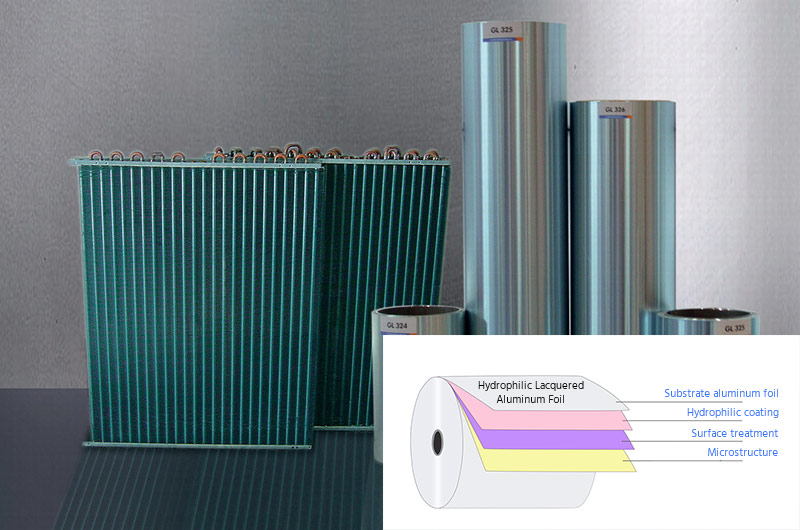
Hydrophilic Aluminum Foil Parameters
| Coating thickness | 1.0~3.0μm (The average thickness of single side) |
| Hydrophilia | The initial hydrophilic angle≤5; Continuous hydrophilic angle≤25 |
| Adhesive force | Cupping Test (pressure deep 5mm): no flaking. Grid experiment (100/100): no delaminating. |
| Corrosion resistance | Salt fog test (72 Hours) R.N≥9.5 |
| Alkali resistance | With 20 degree centigrade, soak in the 20%NaOH with 3 Minutes, the sample coating layer totally no frothing. |
| Solvent resistance | Weight loss of Sample≤1% |
| Heat resistance | Under 200℃, keep for 5 minute, properties and the color remains the same; Under 300℃, keep for 5 minutes, coating layer just become light yellow. |
| Oil resistivity | In the volatile oil soaked for 24 hours, coating layer has no frothing |
- Hydrophilic aluminum foil enhances air conditioning efficiency by promoting the spread of water droplets during condensation, reducing electricity consumption.
- After undergoing degreasing, washing, and drying processes, it exhibits excellent hydrophilicity and corrosion resistance, extending the lifespan of air conditioning units.
- Hydrophilic aluminum foil improves cooling efficiency by 5%, has anti-corrosion properties, is odorless, and prevents water droplet buildup, optimizing air conditioning performance.
Hydrophilic coating specifications of hydrophilic foil
| Categories | Common hydrophilic foil | Self-lubricating hydrophilic foil | High resistance hydrophilic foil |
| Color | Light blue, light gold, dark blue, deep gold | Light blue | Gold |
| Film Weight (g/m²) | 1.7-4.0 | 1.8-2.8 | 2.6-3.8 |
| Original Hydrophilic Diameter | ≥9.0mm | – | – |
| Initial Hydrophilic Angle | ≤10° | – | – |
| Remain Hydrophilic Angle | ≤26° | – | – |
| Adhesion Requirement | Cupping Test (5mm press): No delamination | T Bending Test (180° bend): No delamination or peeling | |
| Corrosion Resistance Test Conditions | 500h continuous neutral salt spray | – | |
| Corrosion Resistance Requirement | R.N-O ≥9.5 | – |
Transparent (Silver) Hydrophilic Aluminum Foil
- Features: Maintains the original metallic luster of aluminum foil with a transparent coating, providing basic hydrophilic properties.
- Applications: Suitable for standard air conditioning systems where appearance is not a priority.
- Advantages: Cost-effective and ideal for mass production of standard products.
Blue Hydrophilic Aluminum Foil
- Features: Offers excellent hydrophilic properties, enabling rapid dispersion of condensation water and preventing water droplet accumulation, which can affect heat exchange efficiency.
- Applications: Widely used in air conditioning evaporators, suitable for household and commercial air conditioners.
- Advantages: Aesthetic blue coating provides additional corrosion resistance.
Gold Hydrophilic Aluminum Foil
- Features: Coating offers superior corrosion resistance, making it suitable for use in demanding environments such as high humidity and high salt spray conditions.
- Applications: Commonly used in condensers or heat exchangers of high-end air conditioning systems.
- Advantages: Premium gold appearance enhances the product’s high-end appeal and durability.
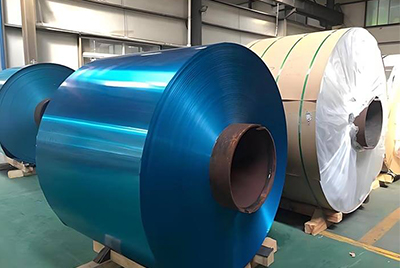
Blue Hydrophilic Aluminum Foil
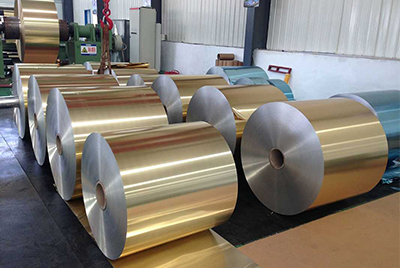
Gold Hydrophilic Aluminum Foil
Hydrophilic foil purchasing guide
1. Cores and Roll Diameter of Chalco hydrophilic foil
| Core I/D | I/D Tolerance | Wall Thickness | Roll O/D (mm) |
| Steel core 76.2mm | ±0.5mm | 2mm | 350-550mm |
| Alu core 76.2mm | ±0.5mm | 4mm | 350-550mm |
| Steel core 152.4mm | ±0.5mm | 3mm | 450-1100mm |
| Alu core 152.4mm | ±0.5mm | 4.5mm | 450-1100mm |
| Paper core 152.4mm | ±0.5mm | 13-17mm | 450-1100mm |
2. Dimensions and Tolerances
- Thickness Tolerance: ±3%
- Width Tolerance: ±1.0mm
- Special tolerance requirements for thickness and width can be customized according to customer needs.
3. Surface Quality
- The surface color of the aluminum foil should be uniform and free from defects that affect usage, such as coating voids, wrinkles, stripes, color differences, scratches, inclusions, and corrosion.
- End Quality: The aluminum foil end face should be tightly and evenly rolled, with no cracks, burrs, or other defects, with overlapping layers ≤2mm and tower shape ≤5mm.
- Joints: Joint rate should not exceed 20%, and joints should be clearly marked.
4. Product Labeling
- Roll Label: Each roll should indicate product name, alloy temper, specifications, weight, roll number, number and position of joints, inspector’s stamp, and company name.
- Box Label: Each box should indicate order number, technical agreement, product name, alloy temper, specifications, box number, gross weight, net weight, production date, and joint count.
5. Coating Performance
- Adhesion Requirements: Cupping Test (pressing depth 5mm): No delamination; T-Bend Test (180° bend): No delamination or peeling.
- Corrosion Resistance: Common hydrophilic foil (blue, gold) 500 hours of continuous neutral salt spray test, R.N-O≥9.5; High-resistance hydrophilic foil (gold): 1500 hours of continuous neutral salt spray test, R.N-O≥9.8.
- Acid and Alkaline Resistance: Coating is free from whitening, blistering, swelling, and shedding.
- Heat Resistance: After being held at 200℃ for 10 minutes, the coating adhesion and color remain stable.
- Oil Resistance: After 48 hours of immersion, no blistering or peeling occurs, with initial hydrophilicity θ≤10°.
- Odor: No abnormal odor under room temperature testing or after baking at 140℃ for 10 minutes. No odor in immersion test.
- Harmful Substance Content: Complies with EU REACH and ROHS standards.
6. Packaging, Transport, and Storage
- Packaging: Cores and packaging boxes should be kept clean, and aluminum foil should be sealed in plastic bags to protect against moisture, with a shelf life of 12 months.
- Storage: In accordance with Chinese National Standard GB/T 3199, avoiding moisture and extreme temperatures.
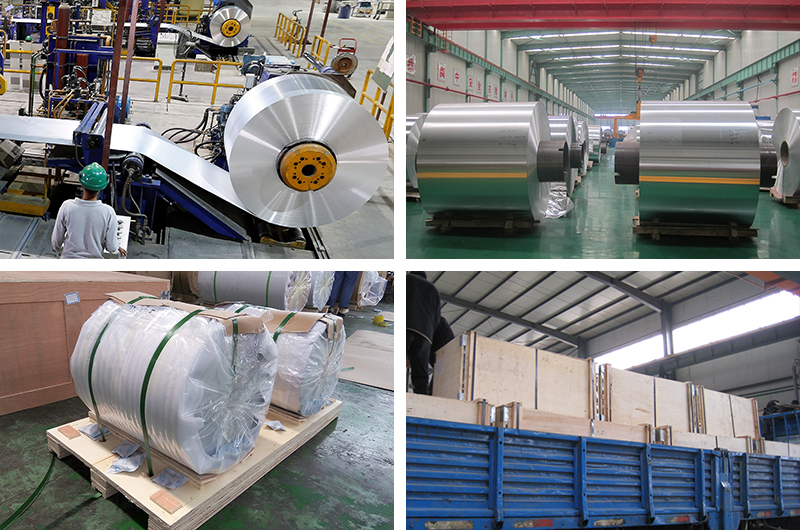
Aluminum foil characteristics
Aluminum foil has a clean, hygienic and shiny appearance. It can be integrated with many other packaging materials to make integrated packaging materials. The printing effect of aluminum foil surface is better than other materials. In addition, aluminum foil has the following characteristics:
(1) The surface of aluminum foil is extremely clean and hygienic. No bacteria or microorganisms can grow on its surface.
(2) Aluminum foil is a non-toxic packaging material. It can be in direct contact with food without any harm to human health.
(3) Aluminum foil is a tasteless and odorless packaging material. It will not make the packaged food have any peculiar smell.
(4) If aluminum foil itself is non-volatile, it itself and the packaged food will never dry or shrink.
(5) Whether at high or low temperatures, aluminum foil will not have grease penetration.
(6) Aluminum foil is an opaque packaging material, so it is a good packaging material for products exposed to sunlight, such as margarine.
(7) Aluminum foil has good plasticity, so it can be used to package products of various shapes. It can also be made into containers of various shapes.
(8) Aluminum foil has high hardness and tensile strength, but its tear strength is low, so it is very easy to tear.
(9) Aluminum foil itself cannot be heat-sealed, and a heat-resistant material such as PE must be applied to its surface to heat-seal it.
(10) Aluminum foil may have adverse reactions when it comes into contact with other heavy metals or heavy metals.
Description
Hot selling aluminum alloy series of hydrophilic lacquered aluminum foil
- 8011 H16 hydrophilic lacquered aluminum foil
For the refrigerant pipes in the air conditioning system and the casing of the outdoor air conditioning unit.
- 1100/1200 O H11 hydrophilic lacquered aluminum foil
Good processability and corrosion resistance, suitable for applications such as air conditioning, heat exchangers, and evaporators.
- 1030B H22 hydrophilic lacquered aluminum foil
Manufacturing of fins for air conditioning systems and industrial radiators. Improve water droplet diffusion and optimize heat exchange performance.
- 3102 H24 hydrophilic lacquered aluminum foil
Used for heating fins for air conditioning systems possess good hydrophilicity and heat dissipation effects.
- 8006 H26 hydrophilic lacquered aluminum foil
It has good hydrophilicity and is suitable for improving the heat exchange efficiency of air conditioning systems.
- 3003 hydrophilic lacquered aluminum foil
Used for hydrophilic fins in air conditioning systems to optimize heat exchange performance.
| Mechanical Properties of Common Aluminum Foil for Hydrophilic Foil | ||||
| Alloy-Temper | Thickness Range (mm) | Tensile Strength (MPa) | Elongation (%) | Cupping Test Value (mm) |
| 1030B H26, 3102 H26 | 0.085-0.09 | 130-140 | ≥13 | ≥5.2 |
| 1030B H26, 3102 H26 | 0.091-0.12 | 130-140 | ≥15 | ≥5.5 |
| 8011-O | 0.10-0.15 | 110-122 | ≥23 | ≥6.0 |
| 0.151-0.25 | 110-122 | ≥25 | ≥6.5 | |
| 8011 H22 | 0.08-0.09 | 115-125 | ≥20 | ≥6.5 |
| 0.091-0.15 | 115-125 | ≥22 | ≥6.0 | |
| 0.151-0.2 | 115-125 | ≥25 | ≥6.5 | |
| 8011 H24 | 0.09-0.2 | 120-135 | ≥22 | ≥6.0 |
The production and structure of hydrophilic foil
Hydrophilic aluminum foil is a special type of aluminum foil that has been treated to have a hydrophilic (water-absorbing) surface. The production process of hydrophilic foil typically involves the following steps:
Raw foil → cleaning → coating (hydrophilic layer, corrosion-resistant layer) → drying and curing → cutting → final hydrophilic foil product.
The finished product encompasses the following structure:
- Substrate aluminum foil: the core material is standard aluminum foil, typically made from high-quality pure aluminum and rolled into thin sheets.
- Hydrophilic coating: hydrophilic properties are achieved by applying a specialized coating on one or both sides of the aluminum foil.
- Surface treatment: hydrophilic coatings are usually applied through chemical or electrochemical processes to make them more attractive to water molecules.
- Microstructure: hydrophilic treatment alters the surface of the aluminum foil, reducing its contact angle with water droplets. This means that water droplets will spread and form a thin film on the surface rather than forming droplets.

Hydrophilic Aluminum Foil Parameters
| Coating thickness | 1.0~3.0μm (The average thickness of single side) |
| Hydrophilia | The initial hydrophilic angle≤5; Continuous hydrophilic angle≤25 |
| Adhesive force | Cupping Test (pressure deep 5mm): no flaking. Grid experiment (100/100): no delaminating. |
| Corrosion resistance | Salt fog test (72 Hours) R.N≥9.5 |
| Alkali resistance | With 20 degree centigrade, soak in the 20%NaOH with 3 Minutes, the sample coating layer totally no frothing. |
| Solvent resistance | Weight loss of Sample≤1% |
| Heat resistance | Under 200℃, keep for 5 minute, properties and the color remains the same; Under 300℃, keep for 5 minutes, coating layer just become light yellow. |
| Oil resistivity | In the volatile oil soaked for 24 hours, coating layer has no frothing |
- Hydrophilic aluminum foil enhances air conditioning efficiency by promoting the spread of water droplets during condensation, reducing electricity consumption.
- After undergoing degreasing, washing, and drying processes, it exhibits excellent hydrophilicity and corrosion resistance, extending the lifespan of air conditioning units.
- Hydrophilic aluminum foil improves cooling efficiency by 5%, has anti-corrosion properties, is odorless, and prevents water droplet buildup, optimizing air conditioning performance.
Hydrophilic coating specifications of hydrophilic foil
| Categories | Common hydrophilic foil | Self-lubricating hydrophilic foil | High resistance hydrophilic foil |
| Color | Light blue, light gold, dark blue, deep gold | Light blue | Gold |
| Film Weight (g/m²) | 1.7-4.0 | 1.8-2.8 | 2.6-3.8 |
| Original Hydrophilic Diameter | ≥9.0mm | – | – |
| Initial Hydrophilic Angle | ≤10° | – | – |
| Remain Hydrophilic Angle | ≤26° | – | – |
| Adhesion Requirement | Cupping Test (5mm press): No delamination | T Bending Test (180° bend): No delamination or peeling | |
| Corrosion Resistance Test Conditions | 500h continuous neutral salt spray | – | |
| Corrosion Resistance Requirement | R.N-O ≥9.5 | – |
Transparent (Silver) Hydrophilic Aluminum Foil
- Features: Maintains the original metallic luster of aluminum foil with a transparent coating, providing basic hydrophilic properties.
- Applications: Suitable for standard air conditioning systems where appearance is not a priority.
- Advantages: Cost-effective and ideal for mass production of standard products.
Blue Hydrophilic Aluminum Foil
- Features: Offers excellent hydrophilic properties, enabling rapid dispersion of condensation water and preventing water droplet accumulation, which can affect heat exchange efficiency.
- Applications: Widely used in air conditioning evaporators, suitable for household and commercial air conditioners.
- Advantages: Aesthetic blue coating provides additional corrosion resistance.
Gold Hydrophilic Aluminum Foil
- Features: Coating offers superior corrosion resistance, making it suitable for use in demanding environments such as high humidity and high salt spray conditions.
- Applications: Commonly used in condensers or heat exchangers of high-end air conditioning systems.
- Advantages: Premium gold appearance enhances the product’s high-end appeal and durability.

Blue Hydrophilic Aluminum Foil

Gold Hydrophilic Aluminum Foil
Hydrophilic foil purchasing guide
1. Cores and Roll Diameter of Chalco hydrophilic foil
| Core I/D | I/D Tolerance | Wall Thickness | Roll O/D (mm) |
| Steel core 76.2mm | ±0.5mm | 2mm | 350-550mm |
| Alu core 76.2mm | ±0.5mm | 4mm | 350-550mm |
| Steel core 152.4mm | ±0.5mm | 3mm | 450-1100mm |
| Alu core 152.4mm | ±0.5mm | 4.5mm | 450-1100mm |
| Paper core 152.4mm | ±0.5mm | 13-17mm | 450-1100mm |
2. Dimensions and Tolerances
- Thickness Tolerance: ±3%
- Width Tolerance: ±1.0mm
- Special tolerance requirements for thickness and width can be customized according to customer needs.
3. Surface Quality
- The surface color of the aluminum foil should be uniform and free from defects that affect usage, such as coating voids, wrinkles, stripes, color differences, scratches, inclusions, and corrosion.
- End Quality: The aluminum foil end face should be tightly and evenly rolled, with no cracks, burrs, or other defects, with overlapping layers ≤2mm and tower shape ≤5mm.
- Joints: Joint rate should not exceed 20%, and joints should be clearly marked.
4. Product Labeling
- Roll Label: Each roll should indicate product name, alloy temper, specifications, weight, roll number, number and position of joints, inspector’s stamp, and company name.
- Box Label: Each box should indicate order number, technical agreement, product name, alloy temper, specifications, box number, gross weight, net weight, production date, and joint count.
5. Coating Performance
- Adhesion Requirements: Cupping Test (pressing depth 5mm): No delamination; T-Bend Test (180° bend): No delamination or peeling.
- Corrosion Resistance: Common hydrophilic foil (blue, gold) 500 hours of continuous neutral salt spray test, R.N-O≥9.5; High-resistance hydrophilic foil (gold): 1500 hours of continuous neutral salt spray test, R.N-O≥9.8.
- Acid and Alkaline Resistance: Coating is free from whitening, blistering, swelling, and shedding.
- Heat Resistance: After being held at 200℃ for 10 minutes, the coating adhesion and color remain stable.
- Oil Resistance: After 48 hours of immersion, no blistering or peeling occurs, with initial hydrophilicity θ≤10°.
- Odor: No abnormal odor under room temperature testing or after baking at 140℃ for 10 minutes. No odor in immersion test.
- Harmful Substance Content: Complies with EU REACH and ROHS standards.
6. Packaging, Transport, and Storage
- Packaging: Cores and packaging boxes should be kept clean, and aluminum foil should be sealed in plastic bags to protect against moisture, with a shelf life of 12 months.
- Storage: In accordance with Chinese National Standard GB/T 3199, avoiding moisture and extreme temperatures.

Aluminum foil characteristics
Aluminum foil has a clean, hygienic and shiny appearance. It can be integrated with many other packaging materials to make integrated packaging materials. The printing effect of aluminum foil surface is better than other materials. In addition, aluminum foil has the following characteristics:
(1) The surface of aluminum foil is extremely clean and hygienic. No bacteria or microorganisms can grow on its surface.
(2) Aluminum foil is a non-toxic packaging material. It can be in direct contact with food without any harm to human health.
(3) Aluminum foil is a tasteless and odorless packaging material. It will not make the packaged food have any peculiar smell.
(4) If aluminum foil itself is non-volatile, it itself and the packaged food will never dry or shrink.
(5) Whether at high or low temperatures, aluminum foil will not have grease penetration.
(6) Aluminum foil is an opaque packaging material, so it is a good packaging material for products exposed to sunlight, such as margarine.
(7) Aluminum foil has good plasticity, so it can be used to package products of various shapes. It can also be made into containers of various shapes.
(8) Aluminum foil has high hardness and tensile strength, but its tear strength is low, so it is very easy to tear.
(9) Aluminum foil itself cannot be heat-sealed, and a heat-resistant material such as PE must be applied to its surface to heat-seal it.
(10) Aluminum foil may have adverse reactions when it comes into contact with other heavy metals or heavy metals.
Products
Related Products
Related products
Hot selling aluminum alloy series of hydrophilic lacquered aluminum foil
- 8011 H16 hydrophilic lacquered aluminum foil
For the refrigerant pipes in the air conditioning system and the casing of the outdoor air conditioning unit.
- 1100/1200 O H11 hydrophilic lacquered aluminum foil
Good processability and corrosion resistance, suitable for applications such as air conditioning, heat exchangers, and evaporators.
- 1030B H22 hydrophilic lacquered aluminum foil
Manufacturing of fins for air conditioning systems and industrial radiators. Improve water droplet diffusion and optimize heat exchange performance.
- 3102 H24 hydrophilic lacquered aluminum foil
Used for heating fins for air conditioning systems possess good hydrophilicity and heat dissipation effects.
- 8006 H26 hydrophilic lacquered aluminum foil
It has good hydrophilicity and is suitable for improving the heat exchange efficiency of air conditioning systems.
- 3003 hydrophilic lacquered aluminum foil
Used for hydrophilic fins in air conditioning systems to optimize heat exchange performance.
| Mechanical Properties of Common Aluminum Foil for Hydrophilic Foil | ||||
| Alloy-Temper | Thickness Range (mm) | Tensile Strength (MPa) | Elongation (%) | Cupping Test Value (mm) |
| 1030B H26, 3102 H26 | 0.085-0.09 | 130-140 | ≥13 | ≥5.2 |
| 1030B H26, 3102 H26 | 0.091-0.12 | 130-140 | ≥15 | ≥5.5 |
| 8011-O | 0.10-0.15 | 110-122 | ≥23 | ≥6.0 |
| 0.151-0.25 | 110-122 | ≥25 | ≥6.5 | |
| 8011 H22 | 0.08-0.09 | 115-125 | ≥20 | ≥6.5 |
| 0.091-0.15 | 115-125 | ≥22 | ≥6.0 | |
| 0.151-0.2 | 115-125 | ≥25 | ≥6.5 | |
| 8011 H24 | 0.09-0.2 | 120-135 | ≥22 | ≥6.0 |
The production and structure of hydrophilic foil
Hydrophilic aluminum foil is a special type of aluminum foil that has been treated to have a hydrophilic (water-absorbing) surface. The production process of hydrophilic foil typically involves the following steps:
Raw foil → cleaning → coating (hydrophilic layer, corrosion-resistant layer) → drying and curing → cutting → final hydrophilic foil product.
The finished product encompasses the following structure:
- Substrate aluminum foil: the core material is standard aluminum foil, typically made from high-quality pure aluminum and rolled into thin sheets.
- Hydrophilic coating: hydrophilic properties are achieved by applying a specialized coating on one or both sides of the aluminum foil.
- Surface treatment: hydrophilic coatings are usually applied through chemical or electrochemical processes to make them more attractive to water molecules.
- Microstructure: hydrophilic treatment alters the surface of the aluminum foil, reducing its contact angle with water droplets. This means that water droplets will spread and form a thin film on the surface rather than forming droplets.

Hydrophilic Aluminum Foil Parameters
| Coating thickness | 1.0~3.0μm (The average thickness of single side) |
| Hydrophilia | The initial hydrophilic angle≤5; Continuous hydrophilic angle≤25 |
| Adhesive force | Cupping Test (pressure deep 5mm): no flaking. Grid experiment (100/100): no delaminating. |
| Corrosion resistance | Salt fog test (72 Hours) R.N≥9.5 |
| Alkali resistance | With 20 degree centigrade, soak in the 20%NaOH with 3 Minutes, the sample coating layer totally no frothing. |
| Solvent resistance | Weight loss of Sample≤1% |
| Heat resistance | Under 200℃, keep for 5 minute, properties and the color remains the same; Under 300℃, keep for 5 minutes, coating layer just become light yellow. |
| Oil resistivity | In the volatile oil soaked for 24 hours, coating layer has no frothing |
- Hydrophilic aluminum foil enhances air conditioning efficiency by promoting the spread of water droplets during condensation, reducing electricity consumption.
- After undergoing degreasing, washing, and drying processes, it exhibits excellent hydrophilicity and corrosion resistance, extending the lifespan of air conditioning units.
- Hydrophilic aluminum foil improves cooling efficiency by 5%, has anti-corrosion properties, is odorless, and prevents water droplet buildup, optimizing air conditioning performance.
Hydrophilic coating specifications of hydrophilic foil
| Categories | Common hydrophilic foil | Self-lubricating hydrophilic foil | High resistance hydrophilic foil |
| Color | Light blue, light gold, dark blue, deep gold | Light blue | Gold |
| Film Weight (g/m²) | 1.7-4.0 | 1.8-2.8 | 2.6-3.8 |
| Original Hydrophilic Diameter | ≥9.0mm | – | – |
| Initial Hydrophilic Angle | ≤10° | – | – |
| Remain Hydrophilic Angle | ≤26° | – | – |
| Adhesion Requirement | Cupping Test (5mm press): No delamination | T Bending Test (180° bend): No delamination or peeling | |
| Corrosion Resistance Test Conditions | 500h continuous neutral salt spray | – | |
| Corrosion Resistance Requirement | R.N-O ≥9.5 | – |
Transparent (Silver) Hydrophilic Aluminum Foil
- Features: Maintains the original metallic luster of aluminum foil with a transparent coating, providing basic hydrophilic properties.
- Applications: Suitable for standard air conditioning systems where appearance is not a priority.
- Advantages: Cost-effective and ideal for mass production of standard products.
Blue Hydrophilic Aluminum Foil
- Features: Offers excellent hydrophilic properties, enabling rapid dispersion of condensation water and preventing water droplet accumulation, which can affect heat exchange efficiency.
- Applications: Widely used in air conditioning evaporators, suitable for household and commercial air conditioners.
- Advantages: Aesthetic blue coating provides additional corrosion resistance.
Gold Hydrophilic Aluminum Foil
- Features: Coating offers superior corrosion resistance, making it suitable for use in demanding environments such as high humidity and high salt spray conditions.
- Applications: Commonly used in condensers or heat exchangers of high-end air conditioning systems.
- Advantages: Premium gold appearance enhances the product’s high-end appeal and durability.

Blue Hydrophilic Aluminum Foil

Gold Hydrophilic Aluminum Foil
Hydrophilic foil purchasing guide
1. Cores and Roll Diameter of Chalco hydrophilic foil
| Core I/D | I/D Tolerance | Wall Thickness | Roll O/D (mm) |
| Steel core 76.2mm | ±0.5mm | 2mm | 350-550mm |
| Alu core 76.2mm | ±0.5mm | 4mm | 350-550mm |
| Steel core 152.4mm | ±0.5mm | 3mm | 450-1100mm |
| Alu core 152.4mm | ±0.5mm | 4.5mm | 450-1100mm |
| Paper core 152.4mm | ±0.5mm | 13-17mm | 450-1100mm |
2. Dimensions and Tolerances
- Thickness Tolerance: ±3%
- Width Tolerance: ±1.0mm
- Special tolerance requirements for thickness and width can be customized according to customer needs.
3. Surface Quality
- The surface color of the aluminum foil should be uniform and free from defects that affect usage, such as coating voids, wrinkles, stripes, color differences, scratches, inclusions, and corrosion.
- End Quality: The aluminum foil end face should be tightly and evenly rolled, with no cracks, burrs, or other defects, with overlapping layers ≤2mm and tower shape ≤5mm.
- Joints: Joint rate should not exceed 20%, and joints should be clearly marked.
4. Product Labeling
- Roll Label: Each roll should indicate product name, alloy temper, specifications, weight, roll number, number and position of joints, inspector’s stamp, and company name.
- Box Label: Each box should indicate order number, technical agreement, product name, alloy temper, specifications, box number, gross weight, net weight, production date, and joint count.
5. Coating Performance
- Adhesion Requirements: Cupping Test (pressing depth 5mm): No delamination; T-Bend Test (180° bend): No delamination or peeling.
- Corrosion Resistance: Common hydrophilic foil (blue, gold) 500 hours of continuous neutral salt spray test, R.N-O≥9.5; High-resistance hydrophilic foil (gold): 1500 hours of continuous neutral salt spray test, R.N-O≥9.8.
- Acid and Alkaline Resistance: Coating is free from whitening, blistering, swelling, and shedding.
- Heat Resistance: After being held at 200℃ for 10 minutes, the coating adhesion and color remain stable.
- Oil Resistance: After 48 hours of immersion, no blistering or peeling occurs, with initial hydrophilicity θ≤10°.
- Odor: No abnormal odor under room temperature testing or after baking at 140℃ for 10 minutes. No odor in immersion test.
- Harmful Substance Content: Complies with EU REACH and ROHS standards.
6. Packaging, Transport, and Storage
- Packaging: Cores and packaging boxes should be kept clean, and aluminum foil should be sealed in plastic bags to protect against moisture, with a shelf life of 12 months.
- Storage: In accordance with Chinese National Standard GB/T 3199, avoiding moisture and extreme temperatures.

Aluminum foil characteristics
Aluminum foil has a clean, hygienic and shiny appearance. It can be integrated with many other packaging materials to make integrated packaging materials. The printing effect of aluminum foil surface is better than other materials. In addition, aluminum foil has the following characteristics:
(1) The surface of aluminum foil is extremely clean and hygienic. No bacteria or microorganisms can grow on its surface.
(2) Aluminum foil is a non-toxic packaging material. It can be in direct contact with food without any harm to human health.
(3) Aluminum foil is a tasteless and odorless packaging material. It will not make the packaged food have any peculiar smell.
(4) If aluminum foil itself is non-volatile, it itself and the packaged food will never dry or shrink.
(5) Whether at high or low temperatures, aluminum foil will not have grease penetration.
(6) Aluminum foil is an opaque packaging material, so it is a good packaging material for products exposed to sunlight, such as margarine.
(7) Aluminum foil has good plasticity, so it can be used to package products of various shapes. It can also be made into containers of various shapes.
(8) Aluminum foil has high hardness and tensile strength, but its tear strength is low, so it is very easy to tear.
(9) Aluminum foil itself cannot be heat-sealed, and a heat-resistant material such as PE must be applied to its surface to heat-seal it.
(10) Aluminum foil may have adverse reactions when it comes into contact with other heavy metals or heavy metals.

